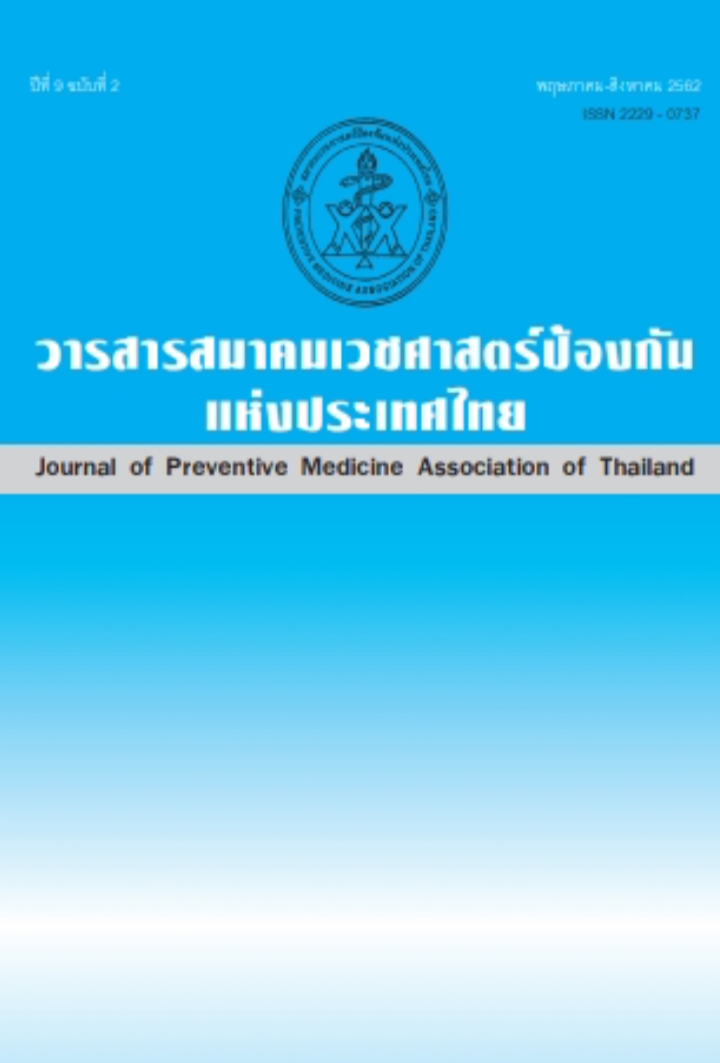The Results of Clinical Practice Guidelines for the Treatment of Alcoholic Withdrawal Syndrome in Inpatients, Nadun Hospital.
Keywords:
alcohol withdrawal, clinical practice guideline, remission rate, remission timeAbstract
Nadun hospital, a small community hospital, has developed clinical practice guidelines for the pharmacological treatment of alcohol withdrawal patients in order to improve standardization of practice, rapid symptomatic control, shorten treatment time, reduce referrals, and without major complications. The aims were to evaluate outcomes on remission rate and duration. This was a prospective descriptive study of inpatients diagnosed with mental and behavioral disorders due to use of alcohol (F10.x) having Clinical Institute Withdrawal Assessment for Alcohol-Revised version (CIWA-Ar) score of 8 or above between 1 December 2016 and 31 March 2019. Remission was defined as when the patient was scoring below 8 on CIWA-Ar for 24 hours. Statistical analysis was performed using percentage, mean, median, and survival analysis. There were 71 patients diagnosed with F10.x, 60.6% had alcoholic withdrawal symptoms, and 14.1% had CIWA-Ar below a score of 8 during the hospitalization. The 33 patients were included in this study. The overall remission rate was 93.9% and the remission rate on day 3, 4, 5 of treatment was 68.8%, 77.4%, and 90.3% respectively. The median remission time was on day 2 of treatment (95% CI: 1.42-2.79). Patients with moderate symptoms had median remission time on day 1.67 (95% CI: 1.38-2.00) while patients with very severe symptoms had median remission time on day 4.33 (95% CI: 1.38-5.54). Average benzodiazepines received equivalent to diazepam was 171.73 (±165.05) mg and average intravenous diazepam was 44.24 (±68.65) mg. There were no major complications or mortality during treatment. The clinical practice guidelines for alcoholic withdrawal syndrome was effective, rapid symptomatic control and safe.
References
2. การสำรวจพฤติกรรมการสูบบุหรี่และบริโภคเครื่องดื่มแอลกอฮอล์ของประชากร พ.ศ. 2560. กรุงเทพฯ:สำนักงานสถิติแห่งชาติ; 2561.
3. Sullivan J, Sykora K, Schneiderman J, Naranjo C, Sellers E. Assessment of alcohol withdrawal: The revised Clinical Institute Withdrawal Assessment for Alcohol scale (CIWA-Ar). Br J Addict 1989;84:1353-7.
4. อภิชาติ ดำรงไชย, กิตติพงศ์ สานิชวรรณกุล, สุรเชษฐ ผ่องธัญญา, กนิษฐน์ เจริญภักดี. การพัฒนาแบบประเมินอาการถอนแอลกอฮอล์. ใน การประชุมวิชาการนานาชาติ ครั้งที่ 2, สุขภาพจิตกับยาเสพติด; 2546; กรุงเทพฯ. หน้า 80-1.
5. พันธุ์นภา กิตติรัตนไพบูลย์, บรรณาธิการ. คู่มือสำหรับผู้ปฏิบัติ รูปแบบการดูแลผู้มีปัญหาการดื่มสุราในระบบสุขภาพ ฉบับปรับปรุง 2554 เชียงใหม่: แผนงานการพัฒนาระบบการดูแลผู้มีปัญหาการดื่มสุรา (ผรส.); 2554.
6. Dundee J, McGowan W, Lilburn J, McKay A, Hegarty J. Comparison of the actions of diazepam and lorazepam. Br J Anaesth 1979;51:439-46.
7. Latouche A, Porcher R, Chevret S. Sample size formula for proportional hazards modeling of competing risks. Stat Med 2004;23:3263-74.
8. Schoenfeld D. Sample-size formula for the proportional-hazards regression model. Biometrics 1983;39:499-503.
9. สุรเชษฐ ผ่องธัญญา, กิตติพงศ์ สานิชวรรณกุล, สมควร วรรณมณี, เมตตา มะโนศรี, วนิดา พุ่มไพศาลชัย, ชิดชนก เรือนก้อน. การใช้ยารักษาอาการขาดสุราในผู้ป่วยที่เข้ารับการรักษาในโรงพยาบาลสวนปรุง. ใน การประชุมวิชาการสุขภาพจิตนานาชาติครั้งที่ 9. กรุงเทพฯ:ม.ป.ท.;2553.
10. ทรงพล โลดทนงค์, นวนันท์ ปิยะวัฒน์กูล, สุวรรณา อรุณพงค์ไพศาล, พงศธร พหลภาคย์, สงวน บุญพูน. อัตราการหายของภาวะขาดสุราหลังจากใช้แนวทางการรักษาของโรงพยาบาลศรีนครินทร์. J Psychiatr Assoc Thailand 2558;60:139-48.
11. Kattimani S, Bharadwaj B. Clinical management of alcohol withdrawal: A systematic review. Ind Psychiatry J 2013;22:100-8.
12. Maldonado J, Sher Y, Das S, Hills-Evans K, Frenklach A, Lolak S, et al. Prospective Validation Study of the Prediction of Alcohol Withdrawal Severity Scale (PAWSS) in Medically Ill Inpatients: A new scale for the prediction of complicated alcohol withdrawal syndrome. Alcohol Alcoholism 2015;50:509-18.
13. Maldonado J. Novel Algorithms for the Prophylaxis and Management of Alcohol Withdrawal Syndromes-Beyond Benzodiazepines. Crit Care Clin 2017;33:559-99.
14. Lee JH, Jang MK, Lee JY, Kim SM, Kim KH, Park JY, et al. Clinical predictors for delirium tremens in alcohol dependence. J Gastroenterol Hepatol 2005;20:1833-7.
15. Palmstierna T. A model for predicting alcohol withdrawal delirium. Psychiatric Services 2001;52:820-3.
16. จินตนา จันทร์โคตรแก้ว, สุรศักดิ์ ไชยสงค์, วุฒิพันธุ์ วงษ์มงคล, สุพล ลิมวัฒนานนท์, ทักษพล ธรรมรังสี. การบริโภคเครื่องดื่มแอลกอฮอล์และความยากจน : ความยากจนจากค่าใช้จ่ายเครื่องดื่มแอลกอฮอล์และรูปแบบการดื่มในกลุ่มฐานะทางเศรษฐกิจที่แตกต่างกัน. วารสารวิชาการสาธารณสุข 2558;24:66-78.
17. Courtney K, Polich J. Binge drinking in young adults: data, definitions, and determinants. Psychol Bull 2009;135:142-56.
18. Vittinghoff E, McCulloch C. Relaxing the rule of ten events per variable in logistic and Cox regression. Am J Epidemiol 2007;165:710-8.
19. Sellers E, Naranjo C, Harrison M, Devenyi P, Roach C, Sykora K. Diazepam loading:simplified treatment of alcohol withdrawal. Clin Pharmacol Ther 1983;34:822-6.
Downloads
Published
How to Cite
Issue
Section
License
บทความที่ลงพิมพ์ในวารสารเวชศาสตร์ป้องกันแห่งประเทศไทย ถือเป็นผลงานวิชาการ งานวิจัย วิเคราะห์ วิจารณ์ เป็นความเห็นส่วนตัวของผู้นิพนธ์ กองบรรณาธิการไม่จำเป็นต้องเห็นด้วยเสมอไปและผู้นิพนธ์จะต้องรับผิดชอบต่อบทความของตนเอง






